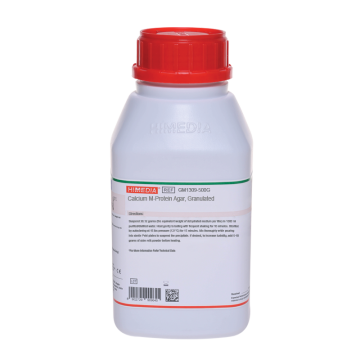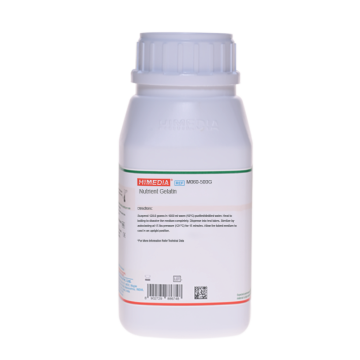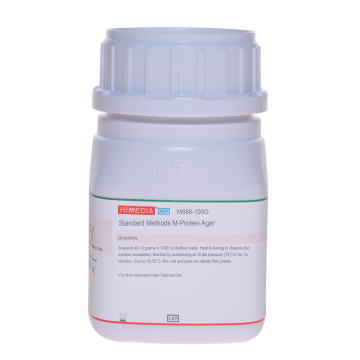 Your enquiry has been submitted
Your enquiry has been submitted
Calcium M- Protein Agar
Proteolytic Microorganisms#CC293D
Intended use
Recommended for the detection and enumeration of proteolytic microorganisms in foodstuffs and other materials.
Composition**
| Ingredients | Gms/Litre |
|---|---|
| Peptone | 4.000 |
| HM extract # | 2.000 |
| Tryptone | 2.000 |
| Calcinate protein ## | 3.500 |
| Calcium chloride, 2H2O | 0.200 |
| Tri-potassium citrate, H20 | 0.350 |
| Disodium hydrogen phosphate | 0.105 |
| Potassium dihydrogen phosphate | 0.035 |
| Sodium chloride | 5.000 |
| Agar | 13.000 |
Final pH (at 25°C): 7.0±0.2
**Formula adjusted, standardized to suit performance parameters
# Equivalent to Meat extract
## Equivalent to Calcium caseinate
Directions
Suspend 30.19 grams (the equivalent weight of dehydrated medium per litre) in 1000 ml purified/distilled water. Heat gently to boiling with frequent shaking for 10 minutes. Sterilize by autoclaving at 15 lbs pressure (121°C) for 15 minutes. Mix thoroughly while pouring into sterile Petri plates to suspend the precipitate. If desired, to increase turbidity, add 5-10 grams of skim milk powder before heating.
Principle And Interpretation
Protein hydrolysis by microorganisms in foods may produce a variety of odour and flavour defects. On the other hand, microbial proteolytic activity may be desirable in certain foods such as in the ripening of cheese, where it contributes to the development of flavour, body and texture. In some foods the level of proteolytic microorganisms may be of value to predict refrigerated storage life and to assess processing methods (2, 6). Calcium M-Protein Agar is a modification of the original formulation of Frazier and Rupp (3) and is used for the detection and enumeration of proteolytic microorganisms in foodstuffs and other materials.
Tryptone, Peptone and HM extract provides nitrogenous, carbonaceous nutrients along with vitamins and amino acids. Phosphates are added to buffer the medium. Sodium chloride maintains the osmotic equilibrium. Calcinate Protein in the medium is degraded by the proteolytic organisms. This results in formation of clear zones around the proteolytic colonies, in the otherwise opaque medium.
Type of specimen
Food and dairy samples
Specimen Collection and Handling
For food and dairy samples, follow appropriate techniques for sample collection and processing as per guidelines (1,7,8). The test sample can be directly surface inoculated or the inoculation can be carried out by the pour plate technique. After an incubation for 24-48 hours, proteolytic organisms, if present will form clear zones on the medium. For better visualization of the zones, the plates can be flooded with 5-10% acetic acid. After use, contaminated materials must be sterilized by autoclaving before discarding.
Warning and Precautions :
Read the label before opening the container. Wear protective gloves/protective clothing/eye protection/face protection. Follow good microbiological lab practices while handling specimens and culture. Standard precautions as per established guidelines should be followed while handling specimens. Safety guidelines may be referred in individual safety data sheets
Limitations :
- 1. Individual
- 2. Further biochemical testing is required for complete identification.
Performance and Evaluation
Performance of the medium is expected when used as per the direction on the label within the when stored at recommended temperature.
Quality Control
Appearance Cream to yellow homogeneous free flowing powder
Gelling Firm, comparable with 1.3% Agar gel.
Colour and Clarity of prepared medium Whitish coloured, turbid gel forms in Petri plates
Reaction Reaction of 3.02% w/v aqueous solution at 25°C. pH: 7.0±0.2
pH 6.80-7.20
Cultural Response
Cultural characteristics observed after an incubation at 35-37°C for 24-48 hours.
| Organism | Inoculum (CFU) | Growth | Recovery | Proteolytic activity |
|---|---|---|---|---|
| Bacillus cereus ATCC 1457950-100 | 50-100 | good-luxuriant | >=70% | positive, clear zone surrounding colonies |
| Escherichia coli ATCC 25922 (00013*) | 50-100 | good-luxuriant | >=70% | negative, no clear zone surrounding colonies |
| Proteus vulgaris ATCC 13315 | good-luxuriant | >=70% | negative, no clear zone surrounding colonies | |
| Pseudomonas aeruginosa ATCC 27853 (00025*) | 50-100 | good-luxuriant | >=70% | positive, clear zone surrounding colonies |
Key: (*) Corresponding WDCM numbers.
Storage and Shelf Life
Store between 10-30°C in a tightly closed container and the prepared medium at 20-30°C. Use before expiry date on the label. On opening, product should be properly stored dry, after tightly capping the bottle in order to prevent lump formation due to the hygroscopic nature of the product. Improper storage of the product may lead to lump formation. Store in dry ventilated area protected from extremes of temperature and sources of ignition. Seal the container tightly after use. Product performance is best if used within stated expiry period.
Disposal
User must ensure safe disposal by autoclaving and/or incineration of used or unusable preparations of this product. Follow established laboratory procedures in disposing of infectious materials and material that comes into contact with sample must be decontaminated and disposed of in accordance with current laboratory techniques (3,4).
Reference
- Chai T., Chen C., Rosen A. and Levin R. E., 1968, Appl. Microbiol., 16: 1738.
- Frazier W. C. and Rupp P., 1928, J. Bacteriol., 16, 57-63
- Isenberg, H.D. Clinical Microbiology Procedures Handbook 2nd Edition.
- Jorgensen, J.H., Pfaller, M.A., Carroll, K.C., Funke, G., Landry, M.L., Richter, S.S and Warnock., D.W. (2015) Manual of Clinical Microbiology, 11th Edition. Vol. 1.
- Martely F. G., Jayashankar S. R. and Lawrence, R. C., 1970, J. Appl. Bacteriol., 33: 363.
- Salfinger Y., and Tortorello M.L., 2015, Compendium of Methods for the Microbiological Examination of Foods, 5th Ed., American Public Health Association, Washington, D.C.
- Wehr H. M. and Frank J. H., 2004, Standard Methods for the Microbiological Examination of Dairy Products, 17th Ed., APHA Inc., Washington, D.C.
| Product Name | Calcium M- Protein Agar |
|---|---|
| SKU | M1309 |
| Product Type | Regular |
| Physical Form | Powder |
| Origin | Animal |
| Packaging type | HDPE |
| References | 1. Chai T., Chen C., Rosen A. and Levin R. E., 1968, Appl. Microbiol.,16: 1738. |
| Customized Product Available | No |










